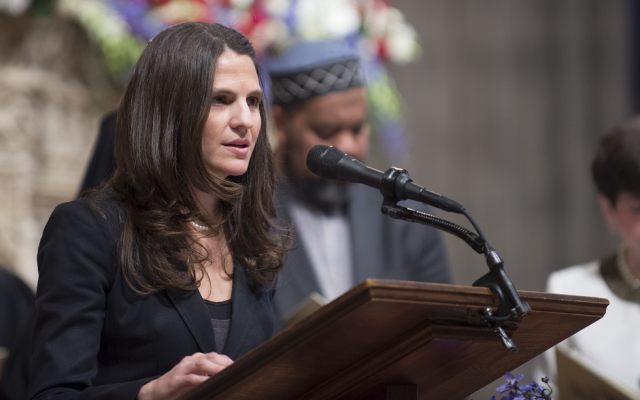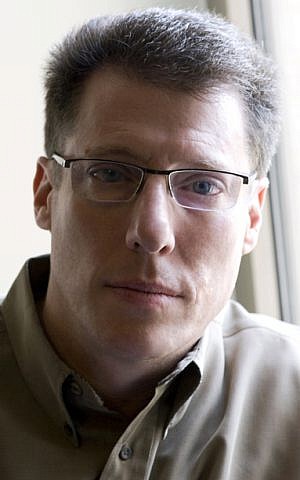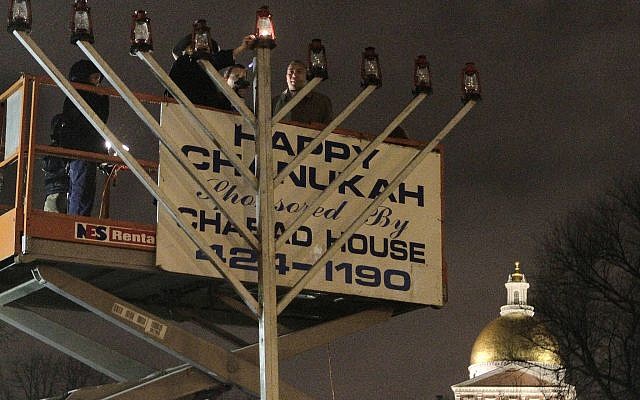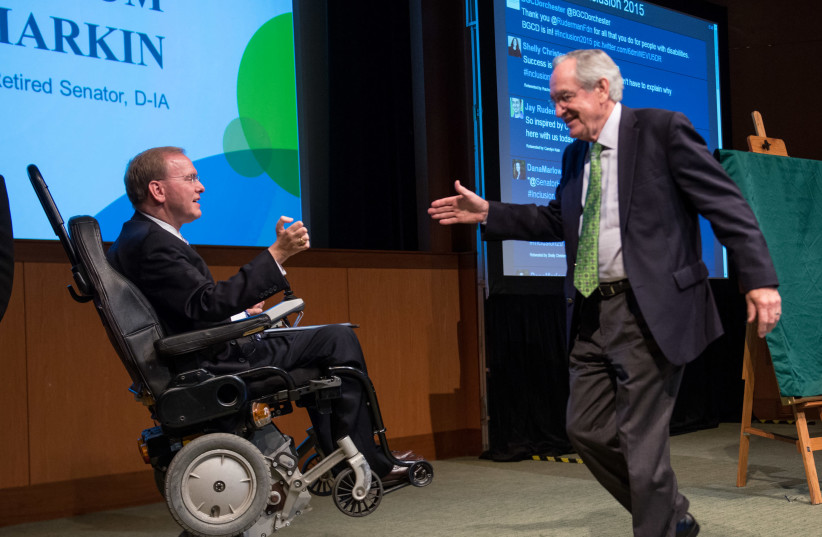NEW YORK JEWISH WEEK — In a speech in 2013, Rabbi Rick Jacobs, president of the Union for Reform Judaism, declared he was living in a “Golden Age of the Jewish people,” in which anti-Semitism was down, Israel was a stable democracy and Jewish communities and creativity were flourishing more than “at almost any other period in Jewish history.”
Jacobs’s speech is one of the most recent texts included in “The New Jewish Canon: Ideas & Debates 1980-2015” (Academic Studies Press), a new anthology co-edited by Yehuda Kurtzer and Claire E. Sufrin. The book brings together 70 essays and ideas from the recent past that “were central to the Jewish communal conversation,” especially to American Jews. Excerpts from the texts are matched with commentary by a present-day author, who puts the original in context.
In contrast to Jacobs’s upbeat speech, anxiety is the dominant theme of many of the texts, whether they are about Israel, intermarriage, anti-Semitism, Holocaust memory, feminism or LGBT inclusion. The past four decades, write Kurtzer and Sufrin, have brought us to a period of “mass instability.”
Kurtzer is president of the Shalom Hartman Institute of North America. Sufrin is associate professor and assistant director of Jewish Studies at Northwestern University. Our conversation was edited for length and clarity.
I want to start by saying I won’t take it personally that you didn’t include my award-winning poem, “I’m a Jew Who Went to State School and I Don’t Care What You Think.” If there is a second volume I may have to lobby for it. But let’s really start with defining what you mean by “canon,” and your intention for the collection.
Yehuda Kurtzer: There are open canons and closed canons, and we really do envision this book as being part of an open and candid conversation. Closed canons are kind of power moves to assert that these are the dominant ideas we’re trying to push. Open canons are a means of helping us understand a particular moment and to shape a conversation about it. We are really eager for a conversation about what are the dominant ideas of the last 30 years and what should have been. There are authors that everybody knows, and there are inclusions where we said no, actually we think this should be part of the conversation because it’s a much bigger deal.

Illustrative: Elie Wiesel (center) during his years as a journalist. (Public domain)
What’s an example?
YK: Claire wrote about Elie Wiesel’s Nobel Peace Prize speech, which is kind of an iconic moment in Jewish history, and we also included Naomi Seidman’s critically important article about the construction of Elie Wiesel. And in doing so we’re signaling not just an iconic moment, but that he is actually a really complicated figure, and part of what it means to understand the legacy of Elie Wiesel is to understand some of the pieces of his legacy that are a little less obvious.
Claire Sufrin: Part of what I love about the pairing of those two pieces is that it hasn’t been that long since he’s died, and while we’re left with this enormous body of writing, he wasn’t particularly part of a movement and there’s no clear successor. So we’re really at this moment of sorting out what his legacy should be, which is a combination of who he was, and also everything that he wrote. You could spend your entire life trying to track down every single essay and novel and memoir he wrote, but the Nobel speech is an incredibly short and important piece of writing that often gets overlooked.
Your essay is about memory but you also write about Wiesel’s relative silence on the Palestinian issue.
CS: Wiesel was iconic through the ‘80s and ‘90s and until his death, because of “Night,” his experience, his writing, but also because of his speaking out in so many other issues. And yet at the end of the day, he was human. He had blinders — and in fact he wasn’t everything that everybody wanted him to be.
At the end of the day, Elie Wiesel was human. He had blinders — and in fact he wasn’t everything that everybody wanted him to be
A lot of the arguments in the book appear to have been settled, in the sense that consensus has been reached on once really contentious issues: women’s equality is accepted by the majority of Jews, so are LGBT rights. It’s acceptable to embrace the peace process and Palestinian rights in ways it wasn’t in 1980. There are exceptions and much unfinished business, of course, but does that ring true with you that this period represents a time of great ferment but also a kind of settling?
CS: What feels very unsettled to me is the conversation around Israel, in particular the war of 1967 and the occupation that emerges from that war, and around the Lebanon War.
YK: The tensions of the American Jewish community around Israel are far from settled. We hope the book is useful precisely on those issues that feel unsettled. But at the same time, we have clearly opened ourselves up to criticism in that there are a set of issues that have emerged much more dramatically in the last four or five years.
What we didn’t do was look at what’s in the news in 2019 and reverse engineer how we got to this moment. That means there are going to be frustrations by some of our readers asking, why didn’t you tackle issue X or Y? Our answer is we are covering the period between 1980 and 2015.
The tensions of the American Jewish community around Israel are far from settled
Two examples might be the Jews of color discussion going on right now and perhaps the struggle for recognition by Mizrachi and Sephardic Jews.
YK: Yes. And I think the #MeToo movement. It implicates some of the choices in this book, but it’s not clear to me that there would have been an obvious choice of antecedent texts that could have predicted where we are today.

Leading sociologist and Jewish social policy researcher Steven M. Cohen. (JTA)
Since we’re there, let me ask the question: When the table of contents was released there was anger that you include selections by three men who faced accusations during the #MeToo movement: sociologist Steven M. Cohen, writer/editor Leon Wieseltier and Israeli journalist Ari Shavit. What did you do in the wake of criticism that, as you write in the introduction, you risked either rehabilitating their reputations or re-traumatizing their accusers?
YK: We didn’t pull anything from the volume, but we gave the responders to their work the opportunity to amend their commentary. And we did swap out one commentary for a different, more critical commentary. And we did go back to our introduction and write more carefully in greater detail about these issues.
CS: Putting people into the book didn’t mean that we thought they are good people or that we agree with their ideas.
Putting people into the book didn’t mean that we thought they are good people or that we agree with their ideas
Speaking as a journalist, I don’t know if there was a more important source for the public understanding of Jewish identity than Steve Cohen, for good and bad, just because of the sheer volume of what he wrote and how dominant he was in discussions about the Jewish communal agenda.
YK: Cohen was the direct author or co-author of something like 35 Jewish community studies. There’s a direct connection to the whole Jewish philanthropic economy, which in turn has huge implications, not just on how we understand America but how we plan Jewish communal life and how we allocate Jewish communal resources. Sociologists like him are not merely documenting Jewish behaviors and practices, but they actually have a normative sensibility in dictating what Jewish communal actions look like about intermarriage, relationships and institutions. One of the real visions for this book was, how do we understand this period of time — not what we think Jewish life should be.
CS: A lot of my colleagues in Jewish studies need sociological data in order to say something meaningful about American Jewish history, and they have no materials to turn to other than what Steven Cohen produced. And the parallel struggle happening among many of them is, how do you take this information, but also wrestle with the legacy of the person who produced it?

An ArtScroll prayer book atop the podium at the Touro Synagogue, the nation’s oldest, in Newport, Rhode Island. (AP/Stephan Savoia)
Tell me about some of the ones that got away, works that may have seemed important at the time they were written but just didn’t have legs, or stuff you wish you had included.
YK: The most frequent reason for rejecting a suggestion was actually over dating. “The Jewish Catalog” came out before 1980, for example. And we excluded fiction, so someone like Philip Roth doesn’t end up in the book despite their having become part of a larger public conversation. There are a few places where we stretched definitions, like “The Complete ArtScroll Siddur,” but I think to do fiction and culture seriously it would require another volume. There’s a great essay to be written about Susie Fishbein and her “Kosher by Design” cookbooks, which had an outsized effect in certain communities about kosher food.
Or how the film “Schindler’s List” shaped the conversation over the Holocaust and memory.
CS: Should somebody interested in issues of Holocaust memory watch “Schindler’s List”? Absolutely. Is it possible to enter the conversation about history and memory from many different angles? Absolutely. We have a whole section on history and memory, and my hope is that a sensitive reader will come out with the kind of tools of analysis that will allow them to understand cultural artifacts about history and memory.
Is it possible to enter the conversation about history and memory from many different angles? Absolutely
You each contribute commentaries in the book. How did you decide which were personal and which you wanted others to write?
YK: Our secondary authors are critical commentators with canonical power. One of my favorite features of the book is like, look at this cool group of people who wrote these pieces about this moment in time. In terms of your question, the Kahan Commission report [on the massacre at the Sabra and Shatilla refugee camps in 1982] was something I felt very passionate about, because it touches on things that I teach about a lot at Hartman, like the question of power and powerlessness in the State of Israel, and the nature of American Jewish conversation about Israel.

Rabbi Sharon Brous of the IKAR congregation in Los Angeles. (Donovan Marks/Washington National Cathedral via JTA)
Yehuda, in your commentary about a bitter exchange between Rabbis Daniel Gordis and Sharon Brous over American Jews’ ability to criticize Israel during the 2012 Gaza operation, you write about the power of the internet and social media in shaping conversations.
YK: The Brous-Gordis debate was very much an online phenomenon, fueled by a lot of anger over what Gordis felt was her betrayal of Israel in its time of need.
The internet is invented. And that changes the way that people write and talk
CS: One of the things that happens during the period of this book is that the internet is invented. And that changes the way that people write and talk. There’s an immediacy that the internet brings to expression, so that rather than essays that might be more carefully developed, the argument is flying back and forth in front of all of our eyes. I don’t know that we yet understand everything that this shift means.

Rabbi Daniel Gordis. (Courtesy of Shalem College)
YK: Our book sits right at that threshold where you see it changing. At the same time, I already see something of a pushback against the idea that serious Jewish discourse should now exclusively be in the form of hot takes. But it wouldn’t surprise me that 30 years from now, we’ll actually realize that there was an ongoing production of serious ideas on Twitter.
Considering the wide divide between the non-Orthodox and Orthodox worlds, especially the Haredim, do you think you were able to capture the internal Orthodox conversation that was happening in this timeframe?
YK: I think it’s a little bit of a miss in the book, that there isn’t a serious essay in the book on the internal theological or political logic of various sectors of Haredi Orthodox Jews, in Israel or America. That said, I think there are two caveats. One is Haredi Jews are still a very small percentage of the Jewish population, even though they occupy an outsized perception by themselves and by the Jews for whom they are the significant other.
The second is, I think that a lot of the essays in the book that are not about Haredi Jews are about Haredi Jews. Multiple essays on Holocaust memory implicate Haredi Judaism. The pieces on the publication of new forms of prayer books are part of that conversation. There is explicit discussion of the Haredi community in the essay [by Donnie Hartman] about Israeli Supreme Court decisions about controlling the public square.
I think that a lot of the essays in the book that are not about Haredi Jews are about Haredi Jews
Were there discoveries for you, perhaps works or debates you hadn’t been aware of or paid much attention to?
CS: The Lubavitcher rebbe wrote a letter in 1981 to the Jewish community of Teaneck defending the public display of menorahs. A thing that now seems so settled was something people were so vehemently opposed to.
YK: Josh Ladon wrote the commentary on Harold Kushner’s “When Bad Things Happen to Good People” — of all the primary texts, his book was the biggest best seller of all with the possible exception of the haggadah. Kushner was doing Jewish theology for a much broader audience, and it was something people actually read.
CS: Kushner is paired with Alan Lew’s “This Is Real and You Are Completely Unprepared,” a spiritual guide to the High Holy Days. Josh’s commentary asks what we lose when people relate to Judaism as individuals instead of community.

Illustrative: A Rabbi from Chabad lights the center light on a 20-foot-high Hanukkah Menorah on the Boston Common, near the Statehouse, in Boston, December 1, 2010. (AP Photo/Steven Senne)
Which is also the theme of another Steven M. Cohen source you include, “The Jew Within,” which he wrote with Arnold Eisen, the former chancellor of the Jewish Theological Seminary, lamenting the breakdown of Jewish communal attachments in favor of personal meaning. The two were accused at the time of nostalgia for an era that had passed. In his commentary on the book, Alan Brill writes, “the older models for conceptualizing Judaism fail to accurately describe our contemporary Jewish communities.” That could be an epigraph for your book.
YK: The story of the book is an earthquake. After the war there is a communal settling down around Israel and about how to make it work as a Jew in America. But by the time you get to the 1980s things are rumbling. The postwar story doesn’t match where Jews are heading on the American side. It’s not coincidental that the Lebanon war and the intifada took place at that same time, totally remaking Israel’s national priorities.
CS: The other day Lex Rofeberg posted on Facebook an article from the Washington Post about the word “Jew,” and someone took issue with a sentence in the article asserting that Jews in the 1950s wanted to be seen as white. Lex responded that it is pretty much historical fact that in the mid-20th century most Jews wanted to be seen that way, even if today it makes us uncomfortable. Our book is about understanding the recent past for what it actually was, so that we can begin to better articulate what we want the community to be.
Related posts:
Views: 0
 RSS Feed
RSS Feed

















 October 15th, 2020
October 15th, 2020  Awake Goy
Awake Goy 




 Posted in
Posted in  Tags:
Tags: 
















